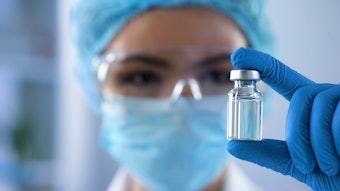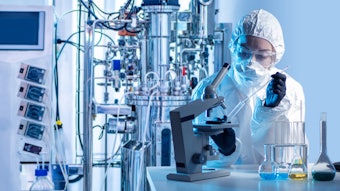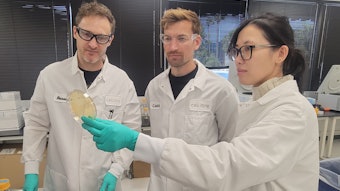Within the market demand for natural solutions, consumers seek products with skin-identical approaches to maintain and improve skin health and beauty. In response, formulators can develop products to improve skin function by focusing on activity in the surface layers of skin as well as stimulating activity from within. In this context, ceramides, which are present in skin and consist of N-acylated sphingoid bases,1 are well-established in the literature for their importance in skin barrier function and stratum corneum (SC) moisturization. However, less has been published on the effects of free sphingoid bases that are also present in skin. Phytosphingosine, typically an 18-carbon chain that incorporates a 2-amino-1,3, 4-triol for its lipid head group, is a free sphingoid base that constitutes part of the chemical antimicrobial barrier of the SC to help control infection. In addition, it can serve many other activities, which are the subject of this literature review.
Phytosphingosine as a PPAR Ligand
The anti-inflammatory and pro-differentiating benefits of phytosphingosine, which will be discussed later in this article, occur through its action as a peroxisomal proliferator activated receptor (PPAR) ligand. Nuclear hormone receptors exert their effects directly on genes by binding to DNA upon their activation by a receptor ligand.2 As an example, readers are likely familiar with the effects of retinoic acid and its mediation via the retinoid receptors, which are part of the superfamily of nuclear hormone receptors. A coordinate control of two families of transcription factors exists that mediates retinoic acid’s effects, namely the retinoid-x-receptor (RXR) and the retinoic acid receptor (RAR). The active transcription factor complex is formed by heterodimerization of the two receptors and binding of their retinoic acid metabolites.
PPARs are also members of this family and have been shown to be important in the regulation and catabolism of dietary fats,3 stimulation of epidermal differentiation,4–5 reduction of inflammation,6–7 and reduction of melanocyte proliferation8 and tyrosinase levels,9 together with reducing the signs of aging.10 Like the retinoid receptor complex, PPARs also form an active complex with RXR; this suggests that the combination of phytosphingosine and retinol might be advantageous since retinoid binding would activate the RXR receptor while phytosphingosine binding would activate the PPAR receptor. The dimerization of both activated receptor molecules would thus trigger highly specific molecular processes related to the above mentioned effects. These activities are regulated through one or more of the three isoforms of PPARs: PPARα, PPARδ and PPARγ. In human skin, epidermal differentiation is predominantly regulated by PPARδ and, to a lesser extent, by PPARα; inflammation through PPARα and some PPARγ; and melanocyte proliferation mainly via PPARγ. Fibroblast function is believed to be mediate via PPARα. Downie et al.11 used human chest sebaceous glands as 7-day cultured whole organs and were able to demonstrate that activators of PPARα and PPARγ inhibited the rate of sebaceous lipogenesis and reduced the synthesis of the sebum specific lipids squalane and triacylglycerol in human sebaceous glands. They concluded that since the suppression of sebum secretion is associated with reduced acne activity, the nuclear hormone receptors involved may open new avenues in the development of novel acne treatments. Most recently, Ottaviani et al.12 reported that increased expression of PPARs induced by squalene peroxides in HaCat keratinocytes leads to the down-regulation of inflammatory mediators.
In vitro, the influence of PPAR agonists on sebocyte lipogenesis is controversial. The work of Zoulboulis13 suggests that PPAR agonists stimulate sebum lipogenesis. Recently, however, PPARγ agonists rather than antagonists have been reported to decrease sebaceous gland size and the dihydro testosterone effects on the glands in the Fuzzy rat.14–15
Since the consensus of the effects of PPAR ligands was considered positive, the authors were interested in the effects of sphingoid derivatives as PPAR agonists. In this respect, Van Veldhoven et al16 first identified that sphingoid bases interact with PPARα, particularly sphingenine, sphinganine and 4D-hydroxysphinganine. Although they reported that N-acyl sphingoids (ceramides) did not bind, Tsuji et al17 found that certain synthetic ceramide analogues bound to all three PPAR isoforms.
On the other hand, Tan et al18 reported that ceramides are PPAR agonists. More importantly for the present discussion, Kim et al19 demonstrated that phytosphingosine activated the transcriptional activity of PPARs in reporter gene assays. Equally, phytosphingosine was shown to be a pan PPAR ligand in the order PPARγ, PPARα and PPARδ with 57%, 36% and 17% activity (see Figure 1). This suggests that phyto-sphingosine can activate the whole PPAR system and may have multiple skin benefits.
Moreover, in the same study,19 real-time polymerase chain reaction (R-T PCR) analysis demonstrated that the mRNA of PPARγ was increased in a dose- and time-dependent manner. A maximum 3.8-fold induction was obtained with a 5 µM concentration of phytosphingosine after a 24-hr treatment. In addition, the authors recently demonstrated a 1.5-fold induction of PPARδ in primary human keratinocytes (data unpublished). The effects of phytosphingosine acting as a PPAR agonist as well as its ability to stimulate the induction of its cognate receptor suggest it would impart pleiotropic skin benefits.
Phytosphingosine in Keratinocyte Differentiation
Considering the described mechanisms, the authors first explored literature on the role of phytosphingosine in epidermal differentiation, since this function is impaired in aged and dry skin. With this condition, aberrations in the formation of the SC and corneocytes occur20 and in this setting, involucrin and loricrin are important for the structural integrity of the corneocytes of the corneocyte envelope. In the case of involucrin, the attachment of covalently bound lipids, i.e. ceramides and fatty acids, mediated by transglutaminase-1, is essential for it to act as a scaffold to assist in the subsequent formation of the lamellar bilayer structure of the SC intercellular lipids. Equally, filaggrin, the precursor to skin’s natural moisturizing factor, also is involved in the compaction and flattening of keratinocytes to corneocytes. Grether-Beck et al.21 demonstrated that phytosphingosine significantly induced the expression of four key keratinocyte differentiation proteins; involucrin by 7-fold, loricrin by 150-fold, transglutaminase-1 by 32-fold, and filaggrin by 37-fold (see Figure 2).
Paragh et al22–23 examined the pro- differentiating effects of phytosphingosine by computational identification of transcription factor binding sites in the gene promoters of a variety of epidermal differentiation-specific transcription factors. Composite promoter models were generated to explain these effects; interestingly, the activator protein-1 protein complex was included in these models (jun and fos proteins). The average gene expression of 53 keratinocyte differentiation marker genes was calculated and phytosphingosine was shown to stimulate them significantly, similar to the effects of vitamin D3.
Phytosphingosine as an Anti-inflammatory
As discussed previously PPARα and PPARγ agonists have been shown to reduce cutaneous inflammatory reactions;6–7 however, phytosphingosine also was shown to inhibit irritant contact dermatitis produced by the topical application of 12-0-tetradecanoylphorbol-13-acetate (TPA).19 It also inhibited epidermal thickening and edema associated with the infiltration of inflammatory cells into the skin by blocking the TPA-induced generation of the pro-inflammatory mediator prostaglandin E2.19
Pavicic et al.24 examined the release of interleukin-1α by untreated, UVB-irradiated human skin explants and found that IL-1α release was increased by a factor of 4.2, compared with non-irradiated skin. However, topical treatment with 0.2% phytosphingosine markedly inhibited the release of IL-1α by 78%, compared with untreated UVB-exposed skin.
To explain these results mechanistically, the effects of phytosphingosine on protein kinase C (PKC), an enzyme involved in downstream signaling in inflammation, were also examined.24 At concentrations of 0.01%, 0.1% and 0.2%, phytosphingosine inhibited approximately 90% of PKC activity compared with the untreated control. Similarly, phytosphingosine was found to inhibit the inflammatory effects of sodium dodecyl sulphate (SDS) by approximately 40–50%, compared with the untreated control, when examined using lactate dehydrogenase and interleukin-1α levels, indicating the anti-inflammatory effect of phytosphingosine (see Figure 3). In keratinocyte cell cultures, phytosphingosine also reduced the expression of the pro-inflammatory mediator and pro-inflammatory chemokines such as interleukin-8 (IL-8), CXCL2 and endothelin-1 (data unpublished).
Most recently, phytosphingosine has been shown to inhibit histamine-induced scratching and vascular permeablility following its topical application.25 This data suggests that phytosphingosine might be useful for the treatment of sensitive skin of which body itching is a component, as well as the itchy scalp that occurs in dandruff.
Phytosphingosine as an Antimicrobial
While Wertz and Downing26 were the first to identify free sphingoid bases in the SC, it was not until the studies of Bibel et al27 that they were recognized as important for antimicrobial activity in the SC. Sphingoid bases, including phytosphingosine, were found to be profoundly effective against Staphylococcus aureus, Micrococcus luteus, Propionibacterium acnes, Brevibacterium epidermidis and Candida albicans, while moderately active against Pseudomonas aeruginosa. Neneoff and Haustein also demonstrated that phytosphingosine inhibited the growth of Malassezia furfur and Candida albicans.28
Further, Pavicic et al24 also demonstrated that even at low concentrations, phytosphingosine inhibited the growth of Gram-positive and Gram-negative bacteria, yeasts and molds. The lowest concentration required for growth inhibition within 1 hr was observed for C. albicans (0.0012%) and the highest was for E. coli (0.040%). For P. acnes, the concentration of phytosphingosine required for growth inhibition within 1 hr was 0.020%. Figure 4 shows the antimicrobial properties of phytosphingosine with respect to P. acnes, which was measured by the number of colony-forming units (CFUs). It was obvious that the outgrowth of bacteria, which occurred at longer inhibition times, was prevented by higher concentrations of phytosphingosine.24
The effect of phytosphingosine was also compared with triclosan in an in vivo study.24 Emulsions were tested on unwashed hands and the percent reduction in microbial counts was determined 1 hr and 4 hr post-product application. After 1 hr, phytosphingosine, phytosphingosine-HCl and triclosan reduced the amount of bacteria on unwashed hands by 68%, 87% and 79%, respectively, and after 4hr, 42%, 68% and 60%, respectively, compared with the effect of the control (0%). The antimicrobial mechanism of sphingoid bases has not yet been sufficiently elucidated and different explanations exist based on such functions as damaging the bacterial cell wall, inhibiting the bacterial protein kinase, bactericidal effects on the cell membrane, and reducing the adherence of bacteria to epithelial cells.24 The preventive antiseptic effect of the closely related sphingoid base sphinganine has already been demonstrated in patients with healthy skin; sphinganine can cause a significant, two-log reduction in the growth of S. aureus and C. albicans in the skin.29 In addition, whereas P. acnes plays a pivotal role particularly in its inflammatory variant, phytosphingosine can inhibit its growth with the minimum inhibitory concentration of 0.020%. This clearly could contribute to clinical efficacy.
Phytosphingosine for Anti-acne
Excessive sebum production, increased P. acnes colonization of the sebaceous gland, ductal epidermal hyperproliferation and aberrant epidermal differentiation, together with inflammation, all contribute to acne.30 Since phytosphingosine has been shown to influence all of these complications, it should be a useful anti-acne agent and indeed, Pavicic et al.24 showed phytosphingosine to be a good anti-acne ingredient both alone as well as in combination with benzoyl peroxide (BPO). Volunteers with moderate inflamed acne on the face participated in a half-face study with evaluations taken at baseline and days 30 and 60. Phytosphingosine was compared with BPO and a combination of the two. Since the combination of BPO and phytosphingosine in formulations was previously shown to be unstable due to chemical interactions between the actives, the compounds were separated from one other in a two-chamber dispenser. Phytosphingosine alone was found to diminish the number of papules and pustules by 89% but not comedones, while BPO alone decreased papules and pustules by 32%, and comedones by 22%.
However, the combination of 0.2% phytosphingosine with 4% BPO resulted in a synergistic effect with a 72% reduction in comedones and 88% reduction in pustules and papules. Nevertheless, a much faster response was observed; after 30 days of treatment, the number of papules/pustules and comedones was diminished by 60% and 43%, respectively, in comparison with a 25% and 6% reduction with phytosphingosine alone, and 10% and 15% with BPO only. Although phytosphingosine was unable to prevent the formation of comedones, it could control the number of comedones induced, whereas the placebo formula alone could not. Typical results for efficacy of phytosphingosine independently and together with BPO are shown in Figures 5 and 6.
Formulating for Phytosphingosine Delivery
Obviously, the delivery of actives into the skin is essential for efficacy, and in the described studies, no attempts were made to optimize skin delivery. However, Schiemann et al.31 studied the delivery of phytosphingosine into porcine skin in Franz cells from emulsions containing emollients with differing polarities; one highly polar, including C12-15 alkyl benzoate/PPG-3 myristyl ether; one of medium polarity, including mineral oil and petrolatum; and one nonpolar, including isohexdecane and cyclomethicone. These experiments revealed that the best penetration was achieved using a formulation with a polar emollient mixture, where approximately 35% of the applied phytosphingosine could be detected by high pressure liquid chromatography in the skin. In contrast, only 18% of the phytosphingosine penetrated into skin with a formulation using medium polarily emollients, and nearly no phytosphingosine was detected in skin using the nonpolar formulation (see Figure 7).
According to Wiechers et al.32–33 three factors must be taken into account to estimate the penetration of an active into the skin: first, the polarity of the active; second, the polarity of the SC; and third, the polarity of the formulation. This is partially in line with the results of Schiemann et al.,31 which clearly show that a variation of the polarity of the emollient in the formulation has an extreme impact on the bioavailability of the active.
In the case of phytosphingosine, the best penetration results were observed with the formulation containing C12-15 alkyl benzoate and PPG-3 myristyl ether, which is a polar emollient mixture having a log P o/w value that is somewhat higher but in the range of the SC and the active. The authors propose that this polarity favors penetration into the skin, partitioning the active from the formulation and diffusing into the skin. A higher difference in the polarity between formulation and active/SC decreased the penetration rate by 45% and thus the bioavailability significantly, which was shown by the mineral oil and petrolatum emollient system. Finally, incorporation of the dimethicone prevented penetration almost completely.
To further prove that increased skin delivery aids efficacy, the same polar and nonpolar cosmetic formulations containing phytosphingosine were topically applied on skin models and the biological activity of involucrin, keratin-10, profilaggrin, transglutaminase-1, loricrin and filaggrin was determined by RT-PCR. The expression of all respective genes appeared to increase when a formulation with polar emollients was used (see Figure 8).31 The right formulation system thus will exploit the different activities of phytosphingosine and further experiments are planned to demonstrate these effects in vivo.
Conclusion
The studies described here demonstrate the multiple benefits of phytosphingosine as a skin-identical sphingoid base. It clearly possesses antimicrobial activity, anti-inflammatory activity and aids the differentiation of keratinocytes. The authors propose the material’s anti-inflammation and differentiation activities are related to its property as a pan-PPAR agonist.As such, phytosphingosine is likely to have many positive skin benefits. Indeed, clinically it has been proven effective as an anti-acne agent when used alone or in combination with traditional anti-acne agents. Further evidence has been presented to improve the delivery of phytosphingosine by use of polar emollients in skin care emulsions; this approach will likely satisfy the consumer need for natural skin care.
References
Send email to [email protected].
1. M Farwick, P Lersch, B Santonnat, K Korevaar and AV Rawlings, Developments in ceramide identification, synthesis, function and nomenclature, Cosm & Toil 124 2 63–72 (2009)
2. M Schmuth, YJ Jiang, D Dubrac, PM Elias and KR Feingold, Thematic review series: Skin lipids. Peroxisome proliferator-activated receptors and liver X receptors in epidermal biology, J Lipid Res 49 3 499–509 (2008)
3. J Berger and DE Moller, The mechanisms of action of PPARs, Annu Rev Med 53 409–435 (2002) 4. K Hanley et al, Keratinocyte differentiation is stimulated by activators of the nuclear hormone receptor PPARalpha, J Invest Dermatol 110 4 368–375 (1998)
5. M Westergaard et al, Modulation of keratinocyte gene expression and differentiation by PPAR-selective ligands and tetradecylthioacetic acid, J Invest Dermatol 116 5 702–712 (2001)
6. S Kippenberger et al, Activators of peroxisome proliferator-activated receptors protect human skin from ultraviolet-B-light-induced inflammation, J Invest Dermatol 117 6 1430–1436 (2001).
7. MY Sheu et al, Topical peroxisome proliferator activated receptor-alpha activators reduce inflammation in irritant and allergic contact dermatitis models, J Invest Dermatol 118 1 94–101 (2002)
8. R Mossner et al, Agonists of peroxisome proliferator-activated receptor gamma inhibit cell growth in malignant melanoma, J Invest Dermatol 119 3 576–82 (2002)
9. JW Wiechers et al, A new mechanism of action for skin whitening agents: Binding to the peroxisome proliferator-activated receptor, Int J Cosmet Sci 27 2 123–32 (2005)
10. AE Mayes et al, Antiaging and skin condition benefits of PPAR activating molecules, 22nd IFSCC Congress, Edinburg, UK (2002)
11. MM Downie, DA Sanders, LM Maier, DM Stock and T Kealey, Peroxisome proliferator-activated receptor and farnesoid X receptor ligands differentially regulate sebaceous differentiation in human sebaceous gland organ cultures in vitro, Br J Dermatol 151 4 766–775 (2004)
12. M Ottaviani, T Alestas, E Flori, A Mastrofrancesco, CC Zouboulis and M Picardo, Peroxidated squalene induces the production of inflammatory mediators in HaCaT keratinocytes: A possible role in Acne vulgaris, J Invest Dermatol 126 11 2430–2437 (2006)
13. CC Zouboulis, S Schagen and T Alestas, The sebocyte culture: A model to study the pathophysiology of the sebaceous gland in sebostasis, seborrhoea and acne, Arch Dermatol Res 300 8 397–413 (2008)
14. M Rivier, P Mauvais and J Boiteau, Selective PPARγ agonists but not antagonists decrease sebaceous gland size in the Fuzzy rats, J Invest Dermatol, 128 S148 (abstract 884) (2008)
15. A Lornard, G Feraille and L Clary, PPARγ agonists antagonize DHT-induced effect on sebaceous glands in the Fuzzy rats, J Invest Dermatol 128 S148 (abstract 886) (2008)
16. PP Van Veldhoven, GP Mannaerts, P Declercq and M Baes, Do sphingoid bases interact with the peroxisome proliferator activated receptor alpha (PPAR-alpha)? Cell Signal 12 7 475–479 (2000)
17. K Tsuji et al, Evaluation of synthetic sphingolipid analogs as ligands for peroxisome proliferator-activated receptors, Bioorg Med Chem Lett 19 6 1643–1646 (2009)
18. NS Tan et al, Critical roles of PPAR beta/delta in keratinocyte response to inflammation, Genes Dev 15 24 3263–3277 (2001)
19. S Kim et al, Phytosphingosine stimulates the differentiation of human keratinocytes and inhibits TPA-induced inflammatory epidermal hyperplasia in hairless mouse skin, Mol Med 12 1–3 17–24 (2006)
20. AV Rawlings and PJ Matts, Stratum corneum moisturization at the molecular level: An update in relation to the dry skin cycle, J Invest Dermatol 124 6 1099–1110 (2005)
21. S Grether-Beck, J Krutmann, C Weitemeyer, M Farwick and P Lersch, Barrier sphingoid bases and barrier ceramides induce differentiation in basal keratinocytes, Proceedings of the IFSCC, Orlando, FL, USA (2004)
22. G Paragh et al, Novel sphingolipid derivatives promote keratinocyte differentiation, Exp Dermatol 17 12 1004–1016 (2008)
23. G Paragh et al, Whole genome transcriptional profiling identifies novel differentiation upregulated genes in keratinocytes, Exp Dermatol (in press) (2010)
24. T Pavicic, U Wollenweber, M Farwick and HC Korting, Anti-microbial and -inflammatory activity and efficacy of phytosphingosine: An in vitro and in vivo study addressing Acne vulgaris, Int J Cosmet Sci 29 3 181–190 (2007)
25. KR Ryu, B Lee, IA Lee, S Oh and DH Kim, Anti-scratching behavioral effects of N-stearoyl-phytosphingosine and 4-hydroxysphinganine in mice, Lipids 45 7 613–618
26. PW Wertz and DT Downing, Free sphingosine in human epidermis, J Invest Dermatol 94 2 159–161 (1990)
27. DJ Bibel et al, Antimicrobial activity of stratum corneum lipids from normal and essential fatty acid-deficient mice, J Invest Dermatol 92 4 632–8 (1989)
28. DJ Bibel, R Aly and HR Shinefield, Antimicrobial activity of sphingosines, J Invest Dermatol 98 3 269–73 (1992)
29. DJ Bibel, R Aly and HR Shinefield, Topical sphingolipids in antisepsis and antifungal therapy, Clin Exp Dermatol 20 5 395–400 (1995)
30. GE Webster, Overview of the pathogenesis of acne, in Acne and its therapy, GF Webster and AV Rawlings, eds, 1(ch 1) (2007) pp 1–7
31. Y Schiemann, M Wegmann, P Lersch, E Heisler and M Farwick, Polar emollients in cosmetic formulations enhance the penetration and biological effects of phytosphingosine on skin, Colloids and surfaces A: Physiochemical and engineering aspects 331 103–107 (2008)
32. JW Wiechers, CL Kelly and TG Blease, Formulation for efficacy, Cosm & Toil 119 3 49–62 (2004)
33. JW Wiechers, The influence of emollients on skin penetration, Cosm & Toil 123 1 46–54 (2008)










